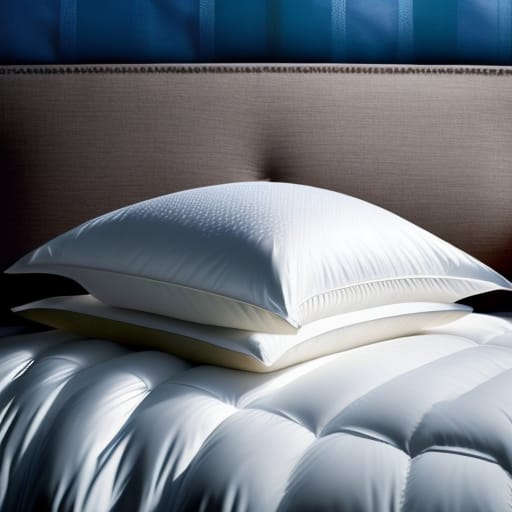Down duvets and pillows are known for their unbeatable softness and insulation, but their production can have environmental impacts. This article explores how to recycle down bedding and reduce textile waste.
What are Down Duvets?
Down duvets are filled with the fluffy undercoating found beneath feathers of ducks and geese. This natural fiber, called down, is extremely lightweight and has incredible loft – the ability to trap lots of air. This loft gives down bedding its renowned warmth without much weight.
The outer shell of the duvet, known as the ticking, is usually made from cotton or cotton-blend fabrics. Down duvets often have baffle box construction on the inside to prevent the filling from clumping or shifting.
Overall, down duvets provide:
- Excellent warmth for their weight
- Light, breathable comfort
- Long-lasting durability over decades
This balance of attributes makes down one of the most versatile and luxurious bedding fills available.
The Importance of Recycling Down
Down and feathers used in duvets and pillows come from ducks and geese as a byproduct of the food industry. No birds are harmed simply for their feathers. However, textile waste often ends up in landfills:
✨ Over 85% of discarded textiles go to landfills or incinerators ✨ Duvets can take over 50 years to decompose
By recycling down bedding instead of trashing it, we can:
- Save valuable materials from the waste stream
- Reduce landfill contributions and carbon emissions
- Promote circular systems that repurpose textiles
Several brands now offer recycled down products made from post-consumer waste. Reusing down diverts it from landfills and reduces the need for new down from ducks and geese.
Down Duvet Recycling Process
Recycling programs like Allied Feather & Down’s L.I.F.E. Program enable consumers to mail in used down bedding. They can then repurpose and sanitize the materials.
The recycling process includes:
- Collection of used down and feather products
- Sorting and cleaning with special washes
- Drying and sanitization to eliminate allergens
- Separating fill materials into categories
- Testing for quality control
- Blending recycled fills to create recycled down
Once the down and small feathers get cleaned, dried, and sterilized, they blend the recycled materials to make new fills. They may mix recycled down with virgin down or feathers to achieve the desired warmth and quality.
Uses for Recycled Down
Upcycled down and feathers find many second lives depending on their condition after cleaning:
- Excellent condition: Fills new down products
- Good condition: Adds fill to items like jackets, comforters etc.
- Lower grade: Gets used for stuffing dog beds, toys etc.
- Damaged/broken: Composted or used in bio-composite materials
Some innovative applications for recycled down and textiles include:
- Insulation in shoes, jackets, sleeping bags
- Fills for pet beds, toys, pillow inserts etc.
- Upholstery padding for furniture and automotives
- Nutrient-rich fertilizer and compost materials
- Composite boards and sustainable building materials
Researchers also develop and test recycled down materials:
- The University of Bath assessed recycled duck feathers in blown insulation
- UniLaSalle in France studied bio-based thermal insulation with recycled fibers
- University of Brighton tested recycled polyester insulation performance
Continued innovation promises expanded future uses for recycled textiles.
Benefits of Recycled Down Bedding
Recycled down and feather fills offer many advantages:
Sustainability: Recycling down diverts waste from landfills and promotes circular production systems. This eco-friendly solution reduces the need for virgin down from birds.
Affordability: Brands like DownLinens sell recycled down duvets, pillows, and more at affordable prices. Their products with 20-50% recycled down can cost 15-30% less than virgin down.
Consistency: Advanced cleaning and blending creates uniform fills that avoid clumping. This consistency matches the feel and performance of new down.
Safety: The intensive sanitization kills dust mites, bacteria, and allergens. This ensures the bedding stays hypoallergenic and safe for those with sensitivities.
Durability: When cared for properly, recycled down offers the same long-lasting durability and insulation as high-quality virgin down.

Purchasing Recycled Down Bedding
More brands now sell bedding with recycled down alternative fills or Responsible Down Standard (RDS) certified recycled goose or duck down.
Top recycled down brands:
- Patagonia – Outdoor gear and apparel brand sells recycled down sleeping bags and jackets.
- DownLinens – Specializes in bedding with recycled down alternative and down fills starting at .
- Allied Feather & Down – Leading supplier of recycled and virgin down. Provides recycled fills to brands and consumers.
- Parachute Home – Bedding startup with duvet inserts featuring RDS certified recycled down.
When choosing recycled down bedding, look for quality ticking with the fill weight and materials noted. Higher fill power numbers, like 600-900, indicate better insulation for the weight. Ticking should have reinforced baffle box construction inside.
Compare options by:
- Fill material (goose down, duck down, down alternative)
- Percentage of recycled content
- Fill power of down
- Construction quality
- Price and value
- Responsible production standards
- Manufacturer warranties on durability
Maintaining Down Duvets
Caring properly for any down duvet can help it last over a decade. Follow these tips:
- Gentle machine wash cycles will clean the ticking without damaging fibers
- Use a mild detergent and tennis balls to prevent clumping
- Tumble dry on low heat with dryer balls to restore loft
- Store flat or hanging to allow airflow and prevent compression
With periodic maintenance washes and air drying when needed, you can maintain the comfort, warmth and integrity of down. Extending its usable life keeps it out of the waste cycle longer.

Future of Down Recycling
As consumers become more sustainability-conscious, demand grows for recycled down and eco-friendly textiles. More brands now prioritize recycled materials and ethical production through initiatives like the Responsible Down Standard (RDS).
Expanded recycling programs, academic studies on applications, and technology allowing traceability of down promise to advance recycling efforts. Collaboration between researchers, suppliers like Allied Down & Feather, and retailers aims to shift the industry.
“At Patagonia, using recycled down fits our mission to build the best product while causing the least environmental harm.” – Jenna Johnson, Patagonia
Continued innovation and consumer support for recycled down could:
- Normalize use of recycled fills in bedding and apparel
- Increase global down recycling rates
- Incentivize sustainable practices across supply chains
- Divert millions of pounds of waste from landfills
Choosing recycled down is an easy way to avoid enabling unnecessary waste in pursuit of comfort. As recycling technology and capabilities advance, recycled down promises to deliver the same exceptional properties consumers love, but in an eco-conscious form.
Frequently Asked Questions
What types of bedding can I recycle?
You can recycle any used down or feather bedding products, including duvets, comforters, pillows, feather beds, and down alternative bedding. Even if it’s worn, torn, or stained, the materials get sorted and separated once recycled.
How much of my duvet contains recycled down?
This depends on the specific product. Many contain blends with anywhere from 20% to 90% recycled down mixed with virgin down and/or feathers. Check item details for the exact percentage of recycled down fills vs feathers.
Should I wash my down duvet before recycling it?
You don’t need to wash items before recycling them. The professional recycling process thoroughly cleans and sanitizes the down and feathers from waste products. Pre-washing could damage the fibers prior to recycling.
Where can I find recycled down pillows and bedding?
Many leading bedding and outdoor gear brands now sell products featuring certified recycled down. Check companies like DownLinens, Parachute Home, Patagonia, and Allied Down & Feather. You can also Google “recycled down blankets,” “recycled down alternative pillows” etc. to find options.
What’s the benefit to buying recycled down?
Choosing bedding with recycled materials keeps waste from landfills, reduces environmental impact, and promotes sustainability. Purchasing these items also supports the expansion of textile recycling programs. Brands can offer recycled down at lower price points as well.
Is recycled down lower quality than virgin down?
No – recycled down offers equal quality, warmth, longevity and hypoallergenic properties compared to virgin down. Advanced cleaning, sanitizing, and blending creates a consistent fill. Follow the care instructions and your recycled down duvet or pillow should last over a decade.
How much does it cost to recycle a duvet?
Recycling services for bedding are often free for consumers. Brands like Allied Down & Feather provide pre-paid recycling bags so you can easily mail in textiles from anywhere in the U.S. Some retailers, like outdoor stores, may also collect old bedding or apparel free of charge for recycling partnerships.








